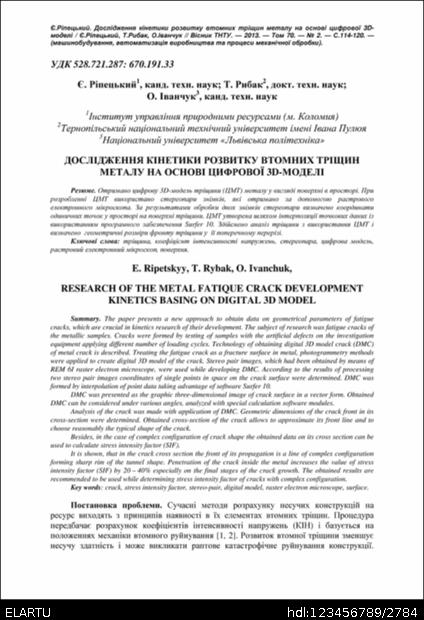Ezzel az azonosítóval hivatkozhat erre a dokumentumra forrásmegjelölésben vagy hiperhivatkozás esetén:
http://elartu.tntu.edu.ua/handle/123456789/2784

| Title: | Дослідження кінетики розвитку втомних тріщин металу на основі цифрової 3d-моделі |
| Other Titles: | Research of the metal fatique crack development kinetics basing on digital 3d model |
| Authors: | Ріпецький, Євген Йосипович Рибак, Тимофій Іванович Іванчук, О. Ripetskyy, E. Rybak, T. Ivanchuk, O. |
| Bibliographic description (Ukraine): | Є.Ріпецький. Дослідження кінетики розвитку втомних тріщин металу на основі цифрової 3D-моделі / Є.Ріпецький, Т.Рибак, О.Іванчук // Вісник ТНТУ. — 2013. — Том 70. — № 2. — С.114-120. — (машинобудування, автоматизація виробництва та процеси механічної обробки). |
| Issue Date: | 20-már-2013 |
| Date of entry: | 4-feb-2014 |
| Publisher: | Тернопільський національний технічний університет ім. Івана Пулюя |
| Place of the edition/event: | Тернопіль, Україна |
| UDC: | 528.721.287 670.191.33 |
| Keywords: | тріщина коефіцієнт інтенсивності напружень стереопара цифрова модель растровий електронний мікроскоп поверхня crack stress intensity factor stereo-pair digital model raster electron microscope surface |
| Abstract: | Отримано цифрову 3D-модель тріщини (ЦМТ) металу у вигляді поверхні в просторі. При розробленні ЦМТ використано стереопари знімків, які отримано за допомогою растрового електронного мікроскопа. За результатами обробки двох знімків стереопари визначено координати одиничних точок у просторі на поверхні тріщини. ЦМТ утворена шляхом інтерполяції точкових даних із використанням програмного забезпечення Surfer 10. Здійснено аналіз тріщини з використання ЦМТ і визначено геометричні розміри фронту тріщини у її поперечному перерізі. The paper presents a new approach to obtain data on geometrical parameters of fatigue cracks, which are crucial in kinetics research of their development. The subject of research was fatigue cracks of the metallic samples. Cracks were formed by testing of samples with the artificial defects on the investigation equipment applying different number of loading cycles. Technology of obtaining digital 3D model crack (DMC) of metal crack is described. Treating the fatigue crack as a fracture surface in metal, photogrammetry methods were applied to create digital 3D model of the crack. Stereo pair images, which had been obtained by means of REM 6I raster electron microscope, were used while developing DMC. According to the results of processing two stereo pair images coordinates of single points in space on the crack surface were determined. DMC was formed by interpolation of point data taking advantage of software Surfer 10. DMC was presented as the graphic three-dimensional image of crack surface in a vector form. Obtained DMC can be considered under various angles, analyzed with special calculation software modules. Analysis of the crack was made with application of DMC. Geometric dimensions of the crack front in its cross-section were determined. Obtained cross-section of the crack allows to approximate its front line and to choose reasonably the typical shape of the crack. Besides, in the case of complex configuration of crack shape the obtained data on its cross section can be used to calculate stress intensity factor (SIF). It is shown, that in the crack cross section the front of its propagation is a line of complex configuration forming sharp rim of the tunnel shape. Penetration of the crack inside the metal increases the value of stress intensity factor (SIF) by 20 – 40% especially on the final stages of the crack growth. The obtained results are recommended to be used while determining stress intensity factor of cracks with complex configuration. |
| URI: | http://elartu.tntu.edu.ua/handle/123456789/2784 |
| ISSN: | 1727-7108 |
| Copyright owner: | © „Вісник Тернопільського національного технічного університету“ |
| Publications status : | Опубліковано раніше |
| Content type: | Article |
| Ebben a gyűjteményben: | Вісник ТНТУ, 2013, № 2 (70) |
Fájlok a dokumentumban:
Minden dokumentum, ami a DSpace rendszerben szerepel, szerzői jogokkal védett. Minden jog fenntartva!